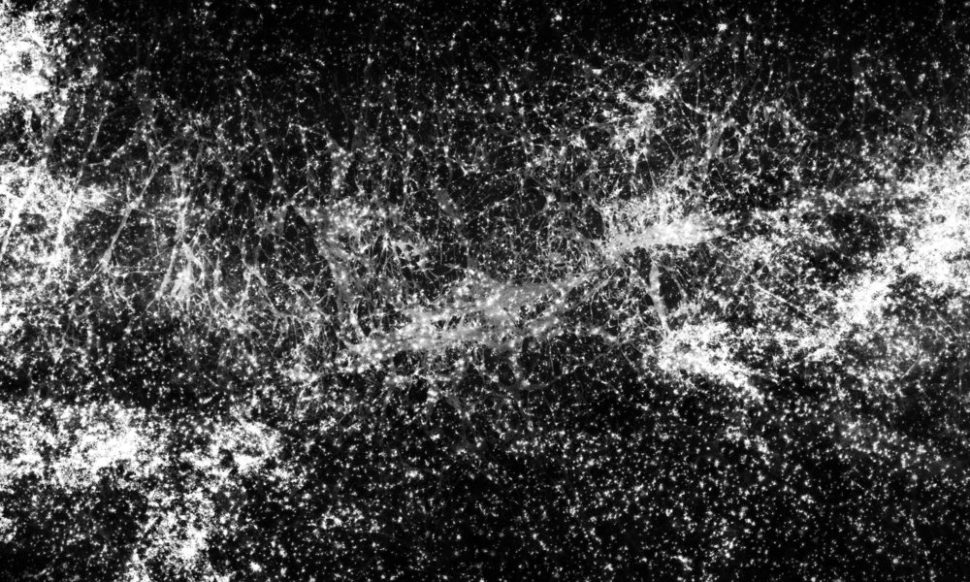Scientists have just detected a mysterious signal from a distant cluster of galaxies that may provide clues as to the nature of dark matter.
Dark matter, along with dark energy, is one of the long-standing mysteries that scientists have yet to figure out.
There are things we know, and things we don’t about dark matter. This mysterious substance has been theorized to be an explanation as to why there’s far more mass than matter in the universe.
Astronomers may have detected dark matter signals for the first time.Click To TweetAfter an 80 year long quest for this elusive substance that supposedly makes up the bulk of the universe, there is still no direct proof of its existence. As it stands, dark matter is still largely seen as a theoretical substance, but new observations may shed light on this mysterious property.
A strange signal, in the form of X-rays, has recently been spotted by scientists using data from three observatories. These researchers think these signals may well be the first scientific measurements of dark matter.
Dark Matter… There? Not There?
Although dark matter and dark energy have become an essential ingredient in the explanation of the evolution of the Universe and a main character in the Big Bang event, there are those who doubt its existence.
According to a recent study by André Maeder, an honorary astronomy professor at the University of Geneva, scientists have been unable to detect dark matter because, simply, it just doesn’t exist.
The study, published on Oct. 31st, attributes the discrepancy between mass and matter in the universe to a fundamental lack of understanding of the nature of gravity. It goes on to suggests a solution to this issue in the form of “scale invariance”.
In physics, as well as in mathematics and economics, the term scale invariance is used to explain that some objects remain constant irrespective of scale and size.
If dark matter is undetectable by telescopes because it emits no light, its effect should be spotted by the gravitational force it exerts on visible matter.
In galaxy clusters, giant galactic structures consisting of several thousand galaxies, the presence of dark matter could explain the abnormally high speeds at which galaxies rotate around the cluster’s center.
At such speeds, galaxies should have the ability to escape the gravitational pull of each others’ mass, unless a mysterious force (i.e., dark matter) is at play, keeping the cluster together.
However, that is not a definitive proof of dark matter’s existence and instead only provides a theoretical reason behind the gravitational nature of galaxy clusters.
Looking for Dark Matter’s Signature
In 2014, a team of astronomers, headed by Esra Bulbul of the Harvard-Smithsonian Center for Astrophysics, used the Chandra and XMM-Newton observations in the Perseus galaxy cluster to discover an intriguing spike in energy intensity.
This spike was also detected across 73 other galaxy clusters and at such intensity (3.5 kilo-electron volts) that scientists theorized that this could not be explained unless it originated from a source of dark matter.
What’s more, another team, from Leiden University in the Netherlands, used the XMM-Newton telescope to find evidence of the 3.5 keV spike in the Perseus cluster, corroborating the findings of the first team.
However, in 2016, Hitomi, an X-ray satellite developed by the Japan Aerospace Exploration Agency (JAXA), failed to detect the 3.5 keV line of emission, throwing the whole investigation into doubt.
A New Hope
A third research group, from Oxford University, set out to solve the puzzle and their findings, as reported by NASA, suggest that the X-ray signal can only be due to the presence of dark matter in the galaxy cluster.
The team re-analyzed data that the Chandra telescope had taken in 2009 of the Perseus cluster.
Rather than a surplus of X-rays, the Oxford team discovered evidence for a dip of X-rays at 3.5 keV, suggesting that “something” in the cluster has been absorbing these rays.
Researchers think that dark matter particles may have two energy states separated by 3.5 keV. This can theoretically be proved when at angles close to the direction of the black hole, an absorption line could be detected, whereas, away from the black hole, an emission line would show.
“This is not a simple picture to paint,” said co-author of the study, Nicholas Jennings, “but it’s possible that we’ve found a way to both explain the unusual X-ray signals coming from Perseus and uncover a hint about what dark matter actually is.”
Now, research teams need further data and analysis, using observatories and X-ray readings from the Perseus and other similar galaxy clusters.
The latest study findings were published in Physical Review D, and are available on arXiv.org.



















Dark Matter is new physics black holes according to Quantum FFF Theory.: http://vixra.org/pdf/1801.0121v2.pdf https://uploads.disquscdn.com/images/4206640861e52e7df2a39a29cbd2c1cda36cffe7f8f885b512b1482779668add.jpg
According to Quantum FFF Theory, Dark Matter is the same as Black hole nuclei made out of compressed ( non spinning) string particles.
As a consequence, black holes have NO inertia but still singular dark energy Casimir gravity.
https://uploads.disquscdn.com/images/324cd4b4e2d165fbfc1c73f5008c2be507e369858a8effbc786f56663d506fb2.jpg